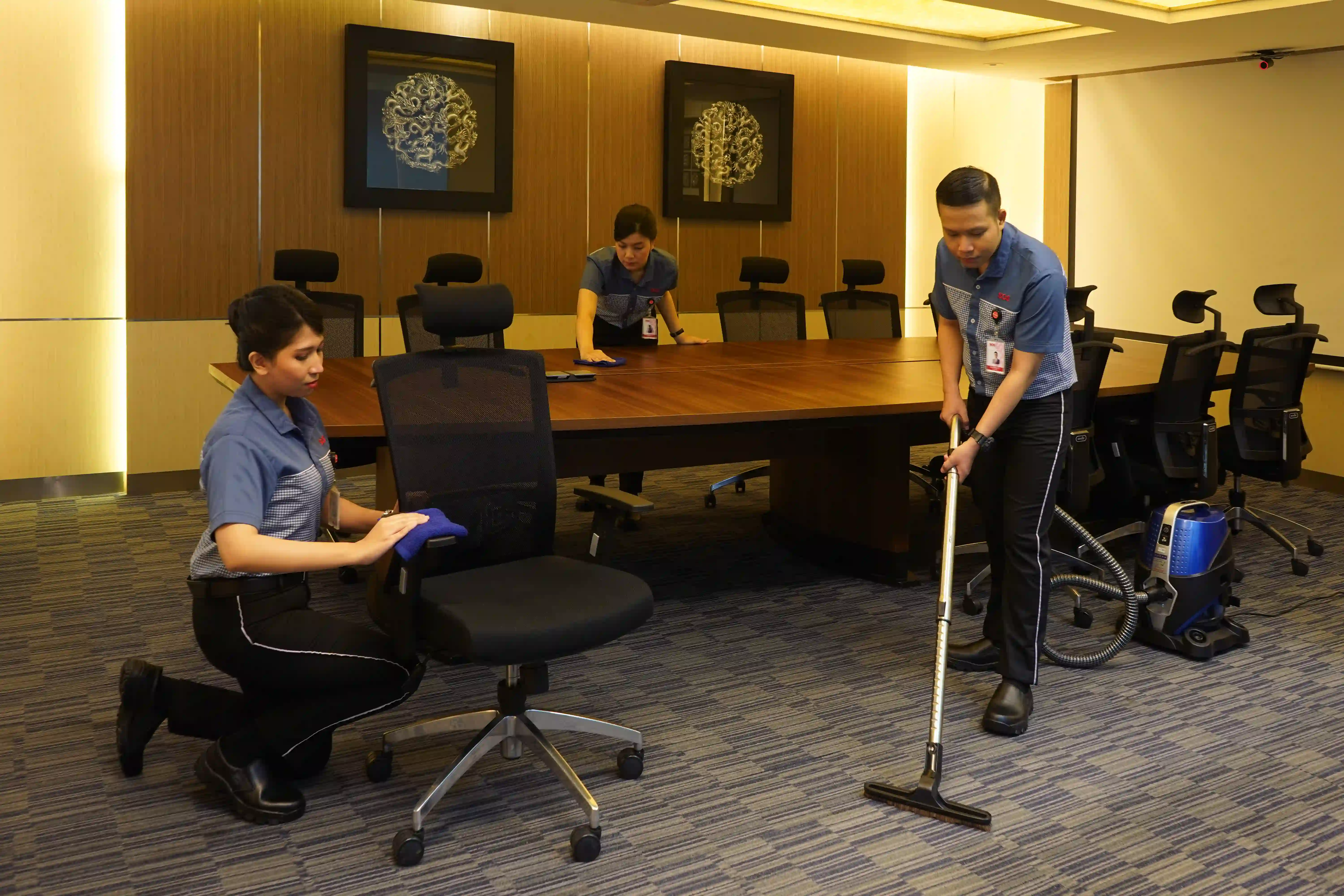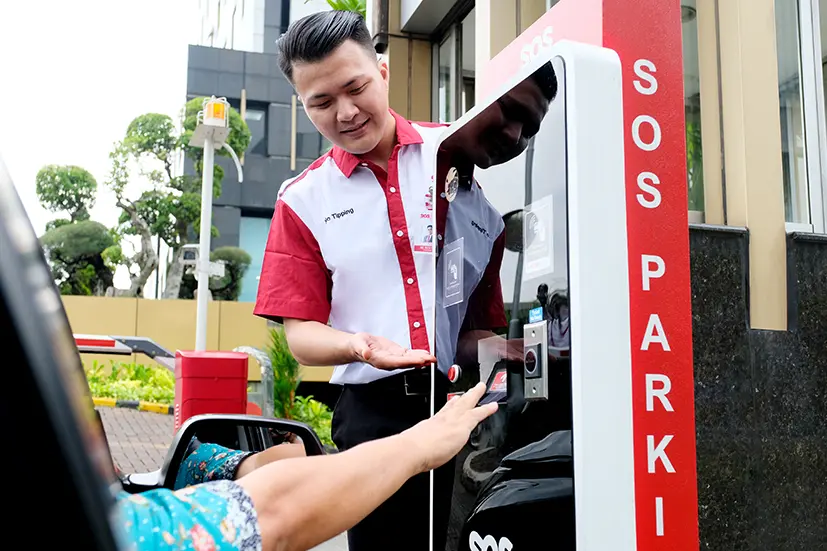10 Office Cleaning SOPs for a Healthy Workplace
26 September 2025

Office cleaning SOPs are not just written rules but an essential foundation for maintaining both health and productivity in the workplace. By applying clear standards, companies can create a neat, comfortable office atmosphere that supports every employee’s performance.
So, how do you create and implement effective cleaning SOPs? Let’s explore the full explanation below.
Ideal Office Cleanliness Conditions to Improve Work Productivity
A clean and organized office environment not only provides comfort but also plays an important role in enhancing employee productivity and well-being. Some characteristics of an ideal office cleanliness standard include:
-
Adequate natural lighting and dust-free work areas that help maintain energy and focus throughout the day.
-
Clean ergonomic desks and chairs that support good posture and reduce fatigue risks.
-
Well-maintained ventilation and air circulation that help protect employee health and concentration.
-
A tidy, hygienic workspace that creates a professional and comfortable atmosphere.
-
A calm environment free from clutter and trash that allows employees to work more efficiently.
Read Also: 7 Office Cleaning Service Tasks for Maximum Cleanliness
10 Office Cleaning SOPs to Maintain Workplace Comfort
Maintaining office cleanliness is not only about aesthetics but directly impacts employee health, comfort, and productivity. Here are some office cleaning SOPs that can be applied to ensure an optimal work environment:
1. Cleaning Individual Workspaces
Every employee has a role in keeping their own work area clean and organized. With simple steps, a workspace can remain neat, hygienic, and germ-free. Actions include:
-
Regularly wiping desks to remove dust and dirt.
-
Organizing cables and electronic devices to avoid clutter.
-
Using disinfectant to clean frequently touched surfaces such as keyboards and mice.
2. Cleaning Shared Areas
Shared spaces such as pantries, meeting rooms, and lobbies are used by many people and require special attention. Keeping these areas clean ensures comfort and minimizes health risks:
-
Clean floors and tables daily.
-
Disinfect shared equipment such as water dispensers, microwaves, and chairs.
-
Sort and dispose of trash regularly to prevent buildup.
3. Maintaining Sanitation Facilities
Restrooms and handwashing areas are critical to overall workplace hygiene. Proper maintenance helps prevent disease transmission:
-
Clean toilets at least twice a day using disinfectants.
-
Refill sinks, faucets, and soap regularly.
-
Ensure ventilation for proper airflow.
4. Maintaining Cleaning Equipment
Well-maintained cleaning tools support effective SOP implementation:
-
Wash and replace vacuums, mops, and cloths regularly.
-
Store disinfectants and cleaning agents safely.
-
Report and repair damaged equipment immediately.
5. Scheduling and Assigning Responsibilities
Establishing a cleaning schedule and assigning responsibilities ensures consistency:
-
Create daily, weekly, and monthly cleaning checklists.
-
Assign responsibility for specific areas.
-
Conduct regular evaluations to ensure compliance.
6. Waste Management and Recycling
Efficient waste management helps maintain cleanliness while supporting sustainability:
-
Separate organic and non-organic waste.
-
Use labeled bins for easy identification.
-
Ensure trash is collected and disposed of on schedule.
7. Floor and Carpet Cleaning
Floors and carpets often collect dust and dirt:
-
Sweep or vacuum daily.
-
Clean spills immediately to prevent stains or odors.
-
Disinfect floors regularly to reduce germs.
8. Cleaning Electronic Devices
Office electronics can harbor germs and require careful cleaning:
-
Wipe keyboards, mice, and monitors with clean cloths and disinfectants.
-
Avoid excessive liquid cleaners to prevent damage.
-
Schedule weekly electronic cleaning routines.
9. Stocking and Maintaining Cleaning Supplies
A steady supply of cleaning products ensures SOPs can be followed without interruption:
-
Maintain adequate stocks of disinfectants, soap, tissues, and brooms.
-
Store supplies in safe yet accessible locations.
-
Monitor inventory regularly to avoid shortages.
10. Employee Training and Awareness
Cleaning SOPs are only effective if employees consistently follow them:
-
Provide briefings or short training sessions on cleaning standards.
-
Place posters and reminders in strategic areas.
-
Encourage employees to remind one another about maintaining cleanliness.
Read Also: 9 Differences Between OB and Cleaning Service Often Misunderstood
6 Ways to Effectively Implement Office Cleaning SOPs
To ensure maximum effectiveness, here are key steps to implement office cleaning SOPs properly:
1. Set Clear Standards and Procedures
Office cleaning SOPs must include clear procedures for every area, from individual workspaces to shared facilities such as the pantry and restrooms.
Well-defined standards make it easier for employees or cleaning teams to understand their tasks, cleaning frequency, and the proper methods to use.
Without clear standards, cleaning practices can become inconsistent and negatively impact both office health and comfort.
2. Establish a Regular Cleaning Schedule
A structured cleaning schedule is key to maintaining office cleanliness consistently.
With a clear schedule, each area receives the necessary attention—daily cleaning for high-touch surfaces, weekly cleaning for common areas, and monthly maintenance for facilities and equipment.
An organized schedule also helps manage cleaning time without disrupting office operations.
3. Assign Responsibilities
The success of SOP implementation relies on clearly assigned responsibilities. Each office area should have a designated person in charge—employees for their desks and cleaning staff for common areas.
With clear task allocation, coordination becomes easier, accountability is maintained, and the risk of neglected areas is minimized.
4. Monitoring and Evaluation
Regular monitoring of SOP implementation ensures that every procedure is properly followed.
Evaluation can be conducted through inspections, checklists, or regular reports.
These evaluations help identify areas for improvement, refine cleaning methods, and ensure cleanliness standards remain consistent over time.
5. Employee Education and Awareness
Employee awareness plays a crucial role in maintaining office cleanliness. Through training, briefings, or reminder posters, employees can better understand their role in keeping a healthy work environment.
With a workplace culture that values cleanliness, SOP implementation becomes more effective and sustainable.
6. Leverage Professional Cleaning Services
For optimal and consistent results, companies can consider hiring trained and professional cleaning services.
Trained cleaning staff understand standard procedures, use the right equipment and products, and work according to predetermined schedules.
With professional support, office cleaning SOPs can be implemented more effectively, keeping the workplace hygienic while ensuring employees remain comfortable and productive.
Read Also: 10 Duties of Office Cleaners for a Comfortable and Productive Workplace
Maintaining office cleanliness through consistent SOP implementation has proven to improve employee comfort, health, and productivity.
To maximize implementation, companies should collaborate with professional and experienced staffing service providers such as SOS.
Maintain Office Cleanliness and Productivity with SOS Professional Cleaning Services
Office cleanliness is not just routine—it’s an investment in employee health and company productivity. With professional cleaning staff, SOPs can be applied effectively without disrupting daily operations.
Advantages of hiring SOS professional cleaning services:
-
Skilled and experienced staff trained in office cleaning SOPs.
-
Time and operational efficiency thanks to professional handling.
-
Consistent cleanliness across all office areas.
-
Use of the right tools and cleaning products for maximum results.
-
Regular monitoring and evaluations to maintain high standards.
Contact us today and let SOS professional cleaning staff take care of your office cleanliness needs—ensuring a healthy, comfortable, and productive workplace.



